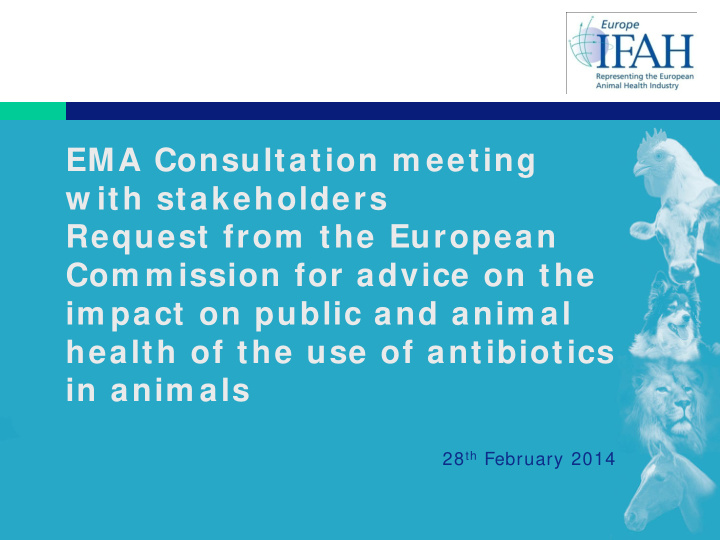



EMA Consultation m eeting w ith stakeholders Request from the European Com m ission for advice on the im pact on public and anim al health of the use of antibiotics in anim als 28 th February 2014
Question 2 : Ranking/ Categorisation • Relevance to Human Health – Most antibiotic classes* used in veterinary medicine are also used in human medicine • Treatment of multi-resistant infections – This is an issue for both human and veterinary medicine • Categorisation/ranking of classes – The remainder of this section addresses categorisation and ranking *(includes aminoglycosides, beta-lactams, fluoroquinolones, lincosamides, macrolides, pleuromutilins, polymyxins , tetracyclines, ………. ) 2
Question 2 : Ranking/ Categorisation • Request is a hybrid between two different issues: – Ranking by importance (CIA list) is hazard identification – Categorisation as 1 st , 2 nd or last choice is a risk management measure (formulary approach) • Both may change over time • Proper risk assessment is lacking 3
Question 2 : Ranking/ Categorisation • Issues with Formulary approach – Resistance selection pressure on 1 st line antibiotic – 2nd line will become 1st – Ignores co-resistance/ co-selection – Should be targeted to specific situation and disease – Declining treatment options over time, if no new antibiotic will be available – Lessons learned from human health experiences 4
Question 2 , Conclusion • The basis for any “critical list” should be the clinical issues associated with resistance • Veterinary medicine deals with multiple species and diseases • Veterinary medicine needs multiple classes of antibiotics, responsibly used This is key to the future longevity of antibiotics, animal health care, innovation and the successful management of antibiotic resistance 5
Question 3 .1 : Treatm ent Gaps • OIE list • Imminent treatment gaps: – Brachyspira hyodystenteriae in swine – MRSP in skin infections in dogs – Rhodococcus equi in horses • Emerging Diseases/ Pathogens/ Strains need consideration • If restrictions on CIAs or new antibiotics e.g . Mycoplasma in cattle and poultry 6
Question 3 .2 : Off-label Use • Industry does not have data • IFAH-Europe believes that off-label use should only be according to the cascade rules (where there is no contra-indication on the SPC) • Off-label use could be rendered unnecessary by: – New claims on existing antibiotics – New classes of veterinary antibiotics Both of these should be incentivised and encouraged 7
Question 3 .3 : Hum an AB Use • There are no approvals or MRLs for these antibiotics in any animal species and thus they are neither marketed nor promoted by the Animal Health industry • In livestock we are unaware of any use – No suitable formulations available • In companion animals, may be very limited use in speciality care 8
Question 3 .4 : MA Refusals • Some applications have been refused • The information is confidential, the regulatory agencies have the information 9
Question 3 .5 : VI CH Guidelines • The VICH guidelines 27 1 and 36 2 offer transparency and predictability • They are welcomed by industry • Any regional deviation would be a considerable setback to innovation 1 – VICH GL 27; Guidance on pre-approval information for registration of new veterinary medicinal products for food producing animals with respect to antimicrobial resistance 2 – VI CH GL 36; Studies to evaluate the safety of residues of veterinary drugs in human food: General Approach to establish a microbiological ADI 10
Question 3 .6 : New ABs and AMR • Development of higher dose/ shorter duration FQs – e.g. Enrofloxacin, Marbofloxacin and Danofloxacin • The potential for resistance development for any antibiotic is carefully evaluated at all stages of the R&D process • It is in our own interest as the industry to maintain the long term viability of our antibiotics 11
Question 4 .1 : Therapeutic Gaps • Given the extensive number of CIAs identified by the WHO, which comprise the majority of antibiotics currently used in veterinary medicine* , the majority of bacterial infections in animals would become untreatable if the use of these CIAs would no longer be permitted in veterinary medicine * (includes dihydrostreptomycin, gentamycin, kanamycin, neomycin, streptomycin, cefoperazone, cefovecin, cefquinome, ceftiofur, danofloxacin, difloxacin, enrofloxacin, ibafloxacin, marbofloxacin, orbifloxacin, erythromycin, spiramycin, gamithromycin, tildipirosin, tilmicosin, tulathromycin, tylosin, tylvalosin, amoxicillin, ampicillin, penicillin G, penicillin V, penethamate HCl, colistin, 12 polymyxin B)
Question 4 .2 : Risk Mitigation ( Anim als) • Yellow card system in Denmark – Increased prevalence of some lesions • Poultry 50% reduction in use, UK – Increased mortality • Pigs, reduction goals, Netherlands – Increase in E. coli and respiratory infections 13
Question 4 .3 : Risk Mitigation ( Hum ans) • Danish organic broiler production – Higher contamination with thermotolerant Campylobacter species • Dutch organic pig herds – MRSA at lower levels but still present • German poultry – No difference in ESBL prevalence between organic and conventional systems • Dutch poultry – Similar levels of ESBL prevalence in organic • Other non-antibiotic factors play a role in selection 14
Question 4 .4 : Risk Mitigation ( Future) • Responsible Use (RU) coupled with Transparency at the Use Phase (Transparency) • Use ‘as little as possible but as much as necessary’ without specific bans or class limitations • Develop approaches which guarantee heterogeneity/ diversity of antimicrobial prescribing • Incentivise and support development of innovation in antibiotics for veterinary use 15
Question 4 .5 : Market Exclusivity • As products come off data protection and generic use commences, prices drop and volumes may increase • In order to address any overuse of antibiotics we need transparency at the use phase as per the response in 4.4 • Innovation should be encouraged by extending data protection to 20 years for antibiotic new chemical entities and an appropriate DP period for variations to existing antibiotics (e.g. optimisation of dosing regime, MUMs and other new indications) 16
Recommend
More recommend